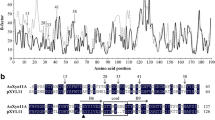Summary
Six mutant xylanases were obtained by in vitro mutagenesis of a xylanase gene from the extremely thermophilic bacterium Caldocellum saccharolyticum. The temperature stability of all enzymes was affected by mutation to various degrees and one of the xylanases had an altered temperature optimum. The mutations had no effect on the pH optimum. The C. saccharolyticum xylanase showed strong homology to several thermophilic and mesophilic xylanases, and comparison of primary sequences allowed the localization of probable active sites and residues involved in thermostability.
Similar content being viewed by others
References
Barany F (1985) Two-codon insertion mutagensis of plasmid gene by using single-stranded hexameric oligonucleotides. Proc Natl Acad Sci USA 85:4202–4206
Bergquist PL, Love DR, Croft JE, Streiff MB, Daniel RM, Morgan WH (1987) Genetics and potential biotechnological applications of thermophilic and extremely thermophilic microorganisms. Biotechnol Genet Eng Rev 5:199–244
Boucher F, Morosoli R, Durand S (1988) Complete nucleotide sequence of the xylanase gene from the yeast Cryptococcus albidus. Nucleic Acids Res 16:9874
Croft JE, Love DR, Bergquist PL (1987) Expression of leucine genes from an extremely thermophilic bacterium in Escherichia coli. Mol Gen Genet 210:490–497
Grépinet O, Chebrou M-C, Béguin P (1988) Nucleotide sequence and deletion analysis of the xylanase gene (xynZ) of Clostridium thermocellum. J Bacteriol 170:4582–4588
Hall J, Hazelwood GP, Huskisson NS, Durrant AJ, Gilbert HJ (1989) Conserved serine-rich sequences in xylanase and cellulase from Pseudomonas fluorescens subspecies cellulosa: internal signal sequence and unusual protein processing. Mol Microbiol 3:1211–1219
Hamamoto T, Honda H, Kudo T, Horikoshi K (1987) Nucleotide sequence of the xylanase gene of alkalophilic Bacillus sp. strain C125. Agric Biol Chem 51:953–955
Henrissat B, Claeyssens M, Tomme P, Lemesle Mornon J-P (1989) Cellulase families revealed by hydrophobic cluster analysis. Gene 81:83–95
Imanaka T, Shibazaki M, Takagi M (1986) A new way of enhancing the thermostability of proteases. Nature 324:695–697
Kantelinen A, Rättö M, Sundquist J, Ranua M, Viikari L, Linko M (1988) Hemicellulases and their potential role in bleaching. In: Salvo TJ de (ed) International Pulp Bleaching Conference, Orlando, Fla. TAPPI Proceedings. Technical Association of the Pulp and Paper Industry, Atlanta, pp 1–4
Knowles J, Lehtovaara P, Teeri T (1987) Cellulase families and their genes. Trends Biotechnol 5:255–261
Lüthi E, Love DR, McAnulty J, Wallace C, Caughey PA, Saul D, Bergquist PL (1990a) Cloning, sequence analysis and expression of xylan-degrading enzymes from the thermophile “Caldocellum saccharolyticum”. Appl Environ Microbiol 56:1017–1024
Lüthi E, Bhana Jasmat N, Bergquist PL (1990b) A xylanase from the extremely thermophilic bacterium “Caldocellum saccharolyticum”: overexpression of the gene in Escherichia coli and characterization of the gene product. Appl Environ Microbiol 56:2677–2683
Matthews BW (1987) Genetic and structural analysis of the protein stability problem. Biochemistry 26:6885–6887
Menéndez-Arias L, Argos P (1989) Engineering protein thermal stability. Sequence statistics point to residue substitutions in α-helices. J Mol Biol 206:397–406
Paice MG, Bernier R Jr, Jurasek L (1988) Viscosity-enhancing bleaching of hardwood kraft pulp with xylanase from a cloned gene. Biotechnol Bioeng 32:235–239
Py B, Bortoli-German I, Haiech J, Chippaux M, Barras F (1991) Cellulase EGZ of Erwinia chrysanthemi: structural organisation and importance of His98 and Glu133 residues for catalysis. Protein Eng 4:325–333
Sambrook J, Fritsch FF, Maniatis T (1989) Molecular cloning: a laboratory manual, 2nd edn. Cold Spring Harbor Laboratory Press, Cold Spring Harbor, N. Y.
Sanger F, Nicklen S, Coulson AR (1977) DNA sequencing with chain-terminating inhibitors. Proc Natl Acad Sci USA 74:5463–5467
Tomazic SJ, Klibanov AM (1988) Why is one Bacillus α-amylase more resistant against irreversible thermoinactivation than another? J Biol Chem 263:3092–3096
Wain-Hobson S, Songio P, Danos O, Cole S, Alison M (1985) Nucleotide sequence of the AIDS virus, LAV. Cell 40:9–17
Wong KKY, Tan LUL, Saddler JN (1988) Multiplicity of β-1,4-xylanases in microorganisms: functions and applications. Microbiol Rev 52:305–317
Zhang X-J, Baase WA, Matthews BW (1991) Toward a simplification of the protein folding problem: a stabilizing polyalanine α-helix engineered in T4 lysozyme. Biochemistry 30:2012–2017
Author information
Authors and Affiliations
Additional information
Offprint requests to: P. L. Bergquist
Rights and permissions
About this article
Cite this article
Lüthi, E., Reif, K., Bhana Jasmat, N. et al. In vitro mutagenesis of a xylanase from the extreme thermophile Caldocellum saccharolyticum . Appl Microbiol Biotechnol 36, 503–506 (1992). https://doi.org/10.1007/BF00170192
Received:
Accepted:
Issue Date:
DOI: https://doi.org/10.1007/BF00170192




